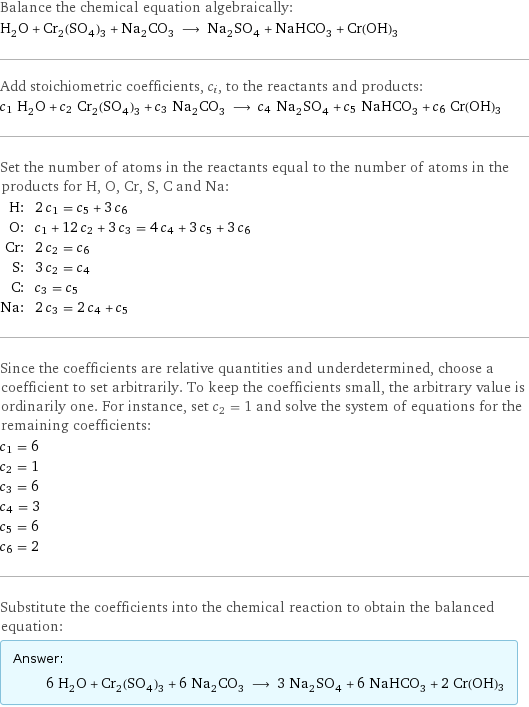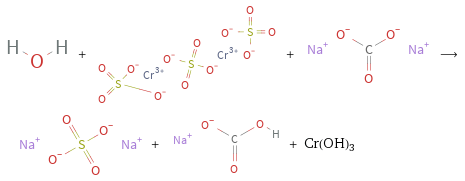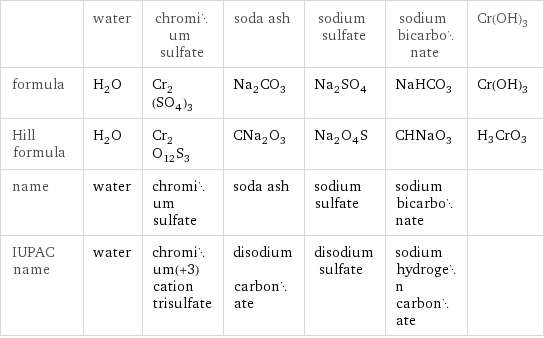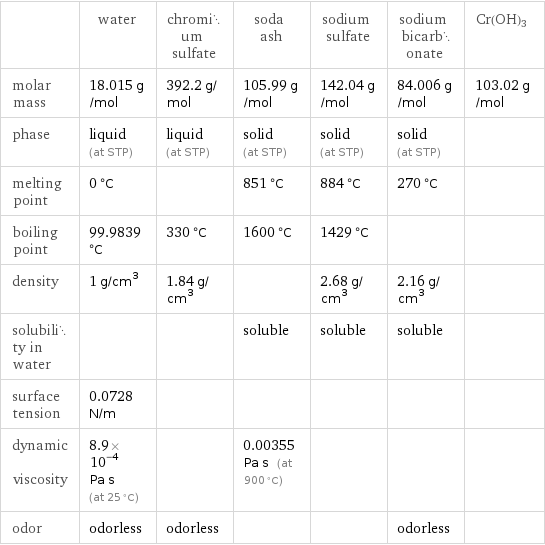Input interpretation

H_2O water + Cr_2(SO_4)_3 chromium sulfate + Na_2CO_3 soda ash ⟶ Na_2SO_4 sodium sulfate + NaHCO_3 sodium bicarbonate + Cr(OH)3
Balanced equation

Balance the chemical equation algebraically: H_2O + Cr_2(SO_4)_3 + Na_2CO_3 ⟶ Na_2SO_4 + NaHCO_3 + Cr(OH)3 Add stoichiometric coefficients, c_i, to the reactants and products: c_1 H_2O + c_2 Cr_2(SO_4)_3 + c_3 Na_2CO_3 ⟶ c_4 Na_2SO_4 + c_5 NaHCO_3 + c_6 Cr(OH)3 Set the number of atoms in the reactants equal to the number of atoms in the products for H, O, Cr, S, C and Na: H: | 2 c_1 = c_5 + 3 c_6 O: | c_1 + 12 c_2 + 3 c_3 = 4 c_4 + 3 c_5 + 3 c_6 Cr: | 2 c_2 = c_6 S: | 3 c_2 = c_4 C: | c_3 = c_5 Na: | 2 c_3 = 2 c_4 + c_5 Since the coefficients are relative quantities and underdetermined, choose a coefficient to set arbitrarily. To keep the coefficients small, the arbitrary value is ordinarily one. For instance, set c_2 = 1 and solve the system of equations for the remaining coefficients: c_1 = 6 c_2 = 1 c_3 = 6 c_4 = 3 c_5 = 6 c_6 = 2 Substitute the coefficients into the chemical reaction to obtain the balanced equation: Answer: | | 6 H_2O + Cr_2(SO_4)_3 + 6 Na_2CO_3 ⟶ 3 Na_2SO_4 + 6 NaHCO_3 + 2 Cr(OH)3
Structures

+ + ⟶ + + Cr(OH)3
Names

water + chromium sulfate + soda ash ⟶ sodium sulfate + sodium bicarbonate + Cr(OH)3
Equilibrium constant
![Construct the equilibrium constant, K, expression for: H_2O + Cr_2(SO_4)_3 + Na_2CO_3 ⟶ Na_2SO_4 + NaHCO_3 + Cr(OH)3 Plan: • Balance the chemical equation. • Determine the stoichiometric numbers. • Assemble the activity expression for each chemical species. • Use the activity expressions to build the equilibrium constant expression. Write the balanced chemical equation: 6 H_2O + Cr_2(SO_4)_3 + 6 Na_2CO_3 ⟶ 3 Na_2SO_4 + 6 NaHCO_3 + 2 Cr(OH)3 Assign stoichiometric numbers, ν_i, using the stoichiometric coefficients, c_i, from the balanced chemical equation in the following manner: ν_i = -c_i for reactants and ν_i = c_i for products: chemical species | c_i | ν_i H_2O | 6 | -6 Cr_2(SO_4)_3 | 1 | -1 Na_2CO_3 | 6 | -6 Na_2SO_4 | 3 | 3 NaHCO_3 | 6 | 6 Cr(OH)3 | 2 | 2 Assemble the activity expressions accounting for the state of matter and ν_i: chemical species | c_i | ν_i | activity expression H_2O | 6 | -6 | ([H2O])^(-6) Cr_2(SO_4)_3 | 1 | -1 | ([Cr2(SO4)3])^(-1) Na_2CO_3 | 6 | -6 | ([Na2CO3])^(-6) Na_2SO_4 | 3 | 3 | ([Na2SO4])^3 NaHCO_3 | 6 | 6 | ([NaHCO3])^6 Cr(OH)3 | 2 | 2 | ([Cr(OH)3])^2 The equilibrium constant symbol in the concentration basis is: K_c Mulitply the activity expressions to arrive at the K_c expression: Answer: | | K_c = ([H2O])^(-6) ([Cr2(SO4)3])^(-1) ([Na2CO3])^(-6) ([Na2SO4])^3 ([NaHCO3])^6 ([Cr(OH)3])^2 = (([Na2SO4])^3 ([NaHCO3])^6 ([Cr(OH)3])^2)/(([H2O])^6 [Cr2(SO4)3] ([Na2CO3])^6)](../image_source/ec7ae99b96550e5f43cbdcbdca6c1a12.png)
Construct the equilibrium constant, K, expression for: H_2O + Cr_2(SO_4)_3 + Na_2CO_3 ⟶ Na_2SO_4 + NaHCO_3 + Cr(OH)3 Plan: • Balance the chemical equation. • Determine the stoichiometric numbers. • Assemble the activity expression for each chemical species. • Use the activity expressions to build the equilibrium constant expression. Write the balanced chemical equation: 6 H_2O + Cr_2(SO_4)_3 + 6 Na_2CO_3 ⟶ 3 Na_2SO_4 + 6 NaHCO_3 + 2 Cr(OH)3 Assign stoichiometric numbers, ν_i, using the stoichiometric coefficients, c_i, from the balanced chemical equation in the following manner: ν_i = -c_i for reactants and ν_i = c_i for products: chemical species | c_i | ν_i H_2O | 6 | -6 Cr_2(SO_4)_3 | 1 | -1 Na_2CO_3 | 6 | -6 Na_2SO_4 | 3 | 3 NaHCO_3 | 6 | 6 Cr(OH)3 | 2 | 2 Assemble the activity expressions accounting for the state of matter and ν_i: chemical species | c_i | ν_i | activity expression H_2O | 6 | -6 | ([H2O])^(-6) Cr_2(SO_4)_3 | 1 | -1 | ([Cr2(SO4)3])^(-1) Na_2CO_3 | 6 | -6 | ([Na2CO3])^(-6) Na_2SO_4 | 3 | 3 | ([Na2SO4])^3 NaHCO_3 | 6 | 6 | ([NaHCO3])^6 Cr(OH)3 | 2 | 2 | ([Cr(OH)3])^2 The equilibrium constant symbol in the concentration basis is: K_c Mulitply the activity expressions to arrive at the K_c expression: Answer: | | K_c = ([H2O])^(-6) ([Cr2(SO4)3])^(-1) ([Na2CO3])^(-6) ([Na2SO4])^3 ([NaHCO3])^6 ([Cr(OH)3])^2 = (([Na2SO4])^3 ([NaHCO3])^6 ([Cr(OH)3])^2)/(([H2O])^6 [Cr2(SO4)3] ([Na2CO3])^6)
Rate of reaction
![Construct the rate of reaction expression for: H_2O + Cr_2(SO_4)_3 + Na_2CO_3 ⟶ Na_2SO_4 + NaHCO_3 + Cr(OH)3 Plan: • Balance the chemical equation. • Determine the stoichiometric numbers. • Assemble the rate term for each chemical species. • Write the rate of reaction expression. Write the balanced chemical equation: 6 H_2O + Cr_2(SO_4)_3 + 6 Na_2CO_3 ⟶ 3 Na_2SO_4 + 6 NaHCO_3 + 2 Cr(OH)3 Assign stoichiometric numbers, ν_i, using the stoichiometric coefficients, c_i, from the balanced chemical equation in the following manner: ν_i = -c_i for reactants and ν_i = c_i for products: chemical species | c_i | ν_i H_2O | 6 | -6 Cr_2(SO_4)_3 | 1 | -1 Na_2CO_3 | 6 | -6 Na_2SO_4 | 3 | 3 NaHCO_3 | 6 | 6 Cr(OH)3 | 2 | 2 The rate term for each chemical species, B_i, is 1/ν_i(Δ[B_i])/(Δt) where [B_i] is the amount concentration and t is time: chemical species | c_i | ν_i | rate term H_2O | 6 | -6 | -1/6 (Δ[H2O])/(Δt) Cr_2(SO_4)_3 | 1 | -1 | -(Δ[Cr2(SO4)3])/(Δt) Na_2CO_3 | 6 | -6 | -1/6 (Δ[Na2CO3])/(Δt) Na_2SO_4 | 3 | 3 | 1/3 (Δ[Na2SO4])/(Δt) NaHCO_3 | 6 | 6 | 1/6 (Δ[NaHCO3])/(Δt) Cr(OH)3 | 2 | 2 | 1/2 (Δ[Cr(OH)3])/(Δt) (for infinitesimal rate of change, replace Δ with d) Set the rate terms equal to each other to arrive at the rate expression: Answer: | | rate = -1/6 (Δ[H2O])/(Δt) = -(Δ[Cr2(SO4)3])/(Δt) = -1/6 (Δ[Na2CO3])/(Δt) = 1/3 (Δ[Na2SO4])/(Δt) = 1/6 (Δ[NaHCO3])/(Δt) = 1/2 (Δ[Cr(OH)3])/(Δt) (assuming constant volume and no accumulation of intermediates or side products)](../image_source/7180964c2285ca416b0b8b53a374099a.png)
Construct the rate of reaction expression for: H_2O + Cr_2(SO_4)_3 + Na_2CO_3 ⟶ Na_2SO_4 + NaHCO_3 + Cr(OH)3 Plan: • Balance the chemical equation. • Determine the stoichiometric numbers. • Assemble the rate term for each chemical species. • Write the rate of reaction expression. Write the balanced chemical equation: 6 H_2O + Cr_2(SO_4)_3 + 6 Na_2CO_3 ⟶ 3 Na_2SO_4 + 6 NaHCO_3 + 2 Cr(OH)3 Assign stoichiometric numbers, ν_i, using the stoichiometric coefficients, c_i, from the balanced chemical equation in the following manner: ν_i = -c_i for reactants and ν_i = c_i for products: chemical species | c_i | ν_i H_2O | 6 | -6 Cr_2(SO_4)_3 | 1 | -1 Na_2CO_3 | 6 | -6 Na_2SO_4 | 3 | 3 NaHCO_3 | 6 | 6 Cr(OH)3 | 2 | 2 The rate term for each chemical species, B_i, is 1/ν_i(Δ[B_i])/(Δt) where [B_i] is the amount concentration and t is time: chemical species | c_i | ν_i | rate term H_2O | 6 | -6 | -1/6 (Δ[H2O])/(Δt) Cr_2(SO_4)_3 | 1 | -1 | -(Δ[Cr2(SO4)3])/(Δt) Na_2CO_3 | 6 | -6 | -1/6 (Δ[Na2CO3])/(Δt) Na_2SO_4 | 3 | 3 | 1/3 (Δ[Na2SO4])/(Δt) NaHCO_3 | 6 | 6 | 1/6 (Δ[NaHCO3])/(Δt) Cr(OH)3 | 2 | 2 | 1/2 (Δ[Cr(OH)3])/(Δt) (for infinitesimal rate of change, replace Δ with d) Set the rate terms equal to each other to arrive at the rate expression: Answer: | | rate = -1/6 (Δ[H2O])/(Δt) = -(Δ[Cr2(SO4)3])/(Δt) = -1/6 (Δ[Na2CO3])/(Δt) = 1/3 (Δ[Na2SO4])/(Δt) = 1/6 (Δ[NaHCO3])/(Δt) = 1/2 (Δ[Cr(OH)3])/(Δt) (assuming constant volume and no accumulation of intermediates or side products)
Chemical names and formulas

| water | chromium sulfate | soda ash | sodium sulfate | sodium bicarbonate | Cr(OH)3 formula | H_2O | Cr_2(SO_4)_3 | Na_2CO_3 | Na_2SO_4 | NaHCO_3 | Cr(OH)3 Hill formula | H_2O | Cr_2O_12S_3 | CNa_2O_3 | Na_2O_4S | CHNaO_3 | H3CrO3 name | water | chromium sulfate | soda ash | sodium sulfate | sodium bicarbonate | IUPAC name | water | chromium(+3) cation trisulfate | disodium carbonate | disodium sulfate | sodium hydrogen carbonate |
Substance properties

| water | chromium sulfate | soda ash | sodium sulfate | sodium bicarbonate | Cr(OH)3 molar mass | 18.015 g/mol | 392.2 g/mol | 105.99 g/mol | 142.04 g/mol | 84.006 g/mol | 103.02 g/mol phase | liquid (at STP) | liquid (at STP) | solid (at STP) | solid (at STP) | solid (at STP) | melting point | 0 °C | | 851 °C | 884 °C | 270 °C | boiling point | 99.9839 °C | 330 °C | 1600 °C | 1429 °C | | density | 1 g/cm^3 | 1.84 g/cm^3 | | 2.68 g/cm^3 | 2.16 g/cm^3 | solubility in water | | | soluble | soluble | soluble | surface tension | 0.0728 N/m | | | | | dynamic viscosity | 8.9×10^-4 Pa s (at 25 °C) | | 0.00355 Pa s (at 900 °C) | | | odor | odorless | odorless | | | odorless |
Units
